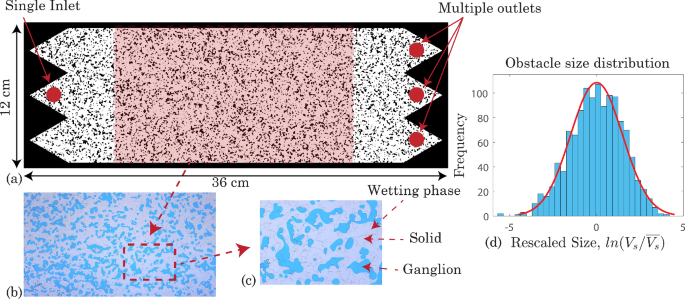Steady-State Dynamics of Ganglia Populations During Immiscible Two-Phase Flows in Porous Micromodels: Effects of the Capillary Number and Flow Ratio on Effective Rheology and Size Distributions
Abstract
We study experimentally the flow of non-wetting ganglia during the co-injection of n-heptane and water in a predominantly 2D PMMA micromodel, which is constructed based on a stochastic digital algorithm. The dynamics of the phase distribution patterns are recorded optically and post-processed using cluster identification and motion tracking algorithms in order to study the characteristics and the interactions between the mobile and stranded ganglia populations. We focus primarily on the effects of the capillary number (Ca) and the ratio of the injection flow rates (Q) on the observed ganglia size distributions and the effective two-phase rheology. Our experimental setup allows for the study of ganglia fragmentation and coalescence dynamics over five orders of magnitude (in terms ganglia sizes), thus offering novel physical insight on the pore-scale characteristics of different ganglia populations and on how their interactions determine the relative permeability of the non-wetting phase. We demonstrate that the rates of ganglia fragmentation and coalescence intensify at higher Ca values, as viscous forces become dominant over capillary ones, leading to a log-normal size distribution that shifts toward smaller mean values. This effect is directly correlated with the emergence of new flow paths that develop progressively through narrower pores-throats, where the continuous wetting phase sweeps ganglia with sizes smaller than the mean pore-throat diameter. These flow paths further contribute to the Darcy scale velocity of the non-wetting phase, thus leading to a power-law Darcian regime at intermediate Ca values with a scaling exponent that is found to be a function of Q.


 求助内容:
求助内容: 应助结果提醒方式:
应助结果提醒方式:


